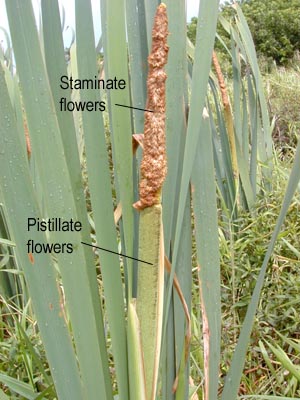Typha latifolia facts for kids
Quick facts for kids Typha latifolia |
|
|---|---|
 |
|
| Mature male flower spike of Typha latifolia; female flower spike beneath it is still green (immature) |
|
| Conservation status | |
| Scientific classification | |
| Genus: |
Typha
|
| Species: |
latifolia
|
| Synonyms | |
|
Synonyms list
Massula latifolia (L.) Dulac
Typha ambigua Schur ex Rohrb. Typha angustifolia var. inaequalis Kronf. Typha angustifolia var. media Kronf. Typha angustifolia var. sonderi Kronf. Typha crassa Raf. Typha elatior Raf. (Illegitimate) Typha elatior Boreau (Illegitimate) Typha elongata Dudley Typha engelmannii A.Br. ex Rohrb. Typha intermedia Schur Typha latifolia var. ambigua Sond. Typha latifolia var. angustifolia Hausskn. Typha latifolia var. bethulona (Costa) Kronf. Typha latifolia subsp. capensis Rohrb. Typha latifolia f. divisa Louis-Marie Typha latifolia var. elata Kronf. Typha latifolia var. elatior Graebn. Typha latifolia var. elongata Dudley Typha latifolia subsp. eulatifolia Graebn. Typha latifolia var. gracilis Godr. Typha latifolia fo. remota Skvortsov Typha latifolia subsp. maresii (Batt.) Batt. Typha latifolia var. obconica Tkachik Typha latifolia var. orientalis (C.Presl) Rohrb. Typha latifolia var. remotiuscula (Schur) Simonk. Typha latifolia subsp. shuttleworthii (W.D.J.Koch & Sond.) Stoj. & Stef. Typha latifolia var. transsilvanica (Schur) Nyman Typha latifolia var. typica Rothm. Typha major Curtis Typha media Pollini (Illegitimate) Typha palustris Bubani Typha pendula Fisch. ex Sond. Typha remotiuscula Schur Typha spathulifolia Kronf. |
|
Typha latifolia, also known as broadleaf cattail or common bulrush, is a tall plant that grows in wet places. You might see it in marshes, ponds, or along riverbanks. It is a perennial plant, meaning it lives for more than two years. It is found all over the world, including North and South America, Europe, Asia, and Africa. In some places, like Australia and Hawaii, it is an introduced plant. This means it was brought there by people. Sometimes it can grow too much, becoming an invasive plant.
Contents
What Does It Look Like?
Broadleaf cattail plants can grow very tall. They usually reach between 1.5 to 3 meters (5 to 10 feet) high. Their leaves are about 2 to 4 centimeters (¾ to 1½ inches) wide. These plants generally grow in water that is about 0.75 to 1 meter (2 to 3 feet) deep.
Where Do Cattails Grow?
Typha latifolia can be found in many different climates. This includes tropical, subtropical, and temperate areas. It grows well in humid coastal regions and dry continental areas too. You can find it from sea level up to about 2,300 meters (7,500 feet) high.
Water Needs
Typha latifolia is an "obligate wetland" species. This means it always grows in or very close to water. It prefers flooded areas where the water is not deeper than 0.8 meters (2.6 feet). However, it can also grow in floating mats in slightly deeper water.
Most cattails grow in fresh water. But they can also be found in slightly salty marshes. If a salty marsh becomes less salty, cattails can start to grow there. They might take over the space from other plants that naturally live in salt marshes. When this happens, the cattail is considered an invasive plant. It can change the natural habitat of the salt marsh.
Related Species
Typha latifolia often grows in the same areas as other similar plants. It can even mix with Typha angustifolia, which is called narrow-leaf cattail. When they mix, they form a new plant called Typha × glauca, or white cattail. Common cattail usually grows in shallower water than narrow-leaf cattail.
How People Use Cattails
Historically, Typha latifolia has been very important to some Indigenous cultures in British Columbia. They used it for food, medicine, and many other things.
Edible Parts
Many parts of the cattail plant can be eaten.
- The underground stems, called rhizomes, can be cooked and peeled.
- The peeled stems and the bases of the leaves can be eaten raw or cooked.
- Young flower spikes, young shoots, and sprouts from the roots are also edible.
- The yellow powder (pollen) from the mature flower spikes can be used to add flavor to food.
- Native Americans would grind the starchy rootstalks into a flour.
Important Safety Note
Cattails grow almost everywhere, even in rural areas. However, it is not safe to eat cattails that come from polluted water. This is because the plant can soak up harmful substances from the water. In fact, cattails are sometimes used to help clean up polluted areas. This process is called bioremediation. Also, you should not eat any cattail that tastes very bitter or spicy.
Images for kids
See also
 In Spanish: Espadaña para niños
In Spanish: Espadaña para niños






